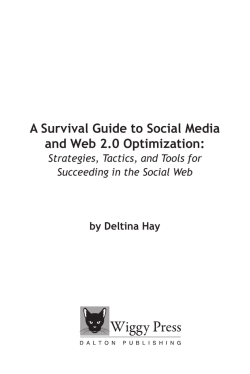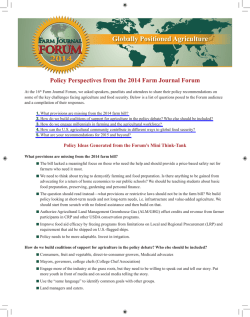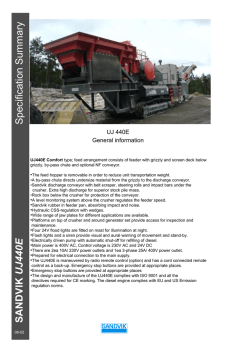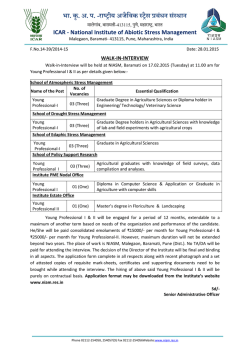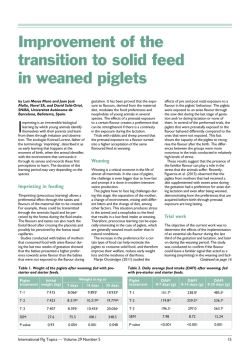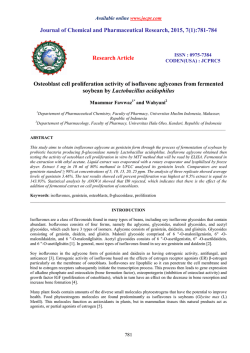
Download (236kB) - Munich Personal RePEc Archive
M PRA Munich Personal RePEc Archive The price trend and their impact on profit margin and safety of the protein for feed in Romania Adrian Gheorghe Zugravu and Maria Magdalena Turek Rahoveanu and Liliana Mihaela Moga and Mihaela Neculita ”Dunarea de Jos” University of Galati, ”Dunarea de Jos” University of Galati, ”Dunarea de Jos” University of Galati, ”Dunarea de Jos” University of Galati 20. November 2014 Online at http://mpra.ub.uni-muenchen.de/61746/ MPRA Paper No. 61746, posted 2. February 2015 10:36 UTC THE PRICE TREND AND THEIR IMPACT ON PROFIT MARGIN AND SAFETY OF THE PROTEIN FOR FEED IN ROMANIA ZUGRAVU GHEORGHE ADRIAN1 TUREK RAHOVEANU MARIA MAGDALENA2 MOGA LILIANA MIHAELA3 NECULITA MIHAELA4 Abstract: Because modern sophistication in the trade, transport, handling, blending and distribution system that makes the feed to reach farmers in the formula "just in time" protein sources are now in difficulty. The paper follows two main objectives: to understand farmers’ perception of safety and quality of protein for stockbreeding and to identify communication levers in order to improve the protein self-sufficiency for animal production. This paper conducted a questionnaire survey of Romanian farmers’ perception toward safety and quality of protein for feed. The empirical study with brands indicated that farmers are different awareness to safety and quality of protein for feed. Key words: safety perception, feed quality, protein self-sufficiency INTRODUCTION While there are various ways to produce animal feed, there are only three major production and delivery systems involved accepted fodder to help farmers producing livestock - cattle or dairy or meat, chickens, laying hens, pigs, rabbits, goats, and sheep or fish. These are: • Commercial operations that produce food for sale; • Integrated operations in which large pig and poultry producers produce their own feed; • Operations cooperative farmers have in common feed factory or production facility that produces food they use. What differentiates industries and why many plants are kept in different countries is the different cultures and skills that are brought in the production of feed. Currently, more than 3,800 feed mills for more than 80% of world production of animal feed. Despite current vertical integration and consolidation in the industry, the world's top 10 producers of feed accounts for more than 65 million tons per year - more than 11% of total production. As a result, global feed industry remains based on local and regional commercial companies, as well as specialized companies. MATERIAL AND METHODS This paper purpose is to investigate and analyze farmers‟ protein for stockbreeding awareness, purchasing behaviour. The present challenges for protein for stockbreeding supply are: Provenience from 150 countries 80% from foreign sources Protein for stockbreeding safety problems common Protein for stockbreeding economic fraud is common Resources to address the problem have been limited Consumer perception not always factual The consumer demand for protein for stockbreeding continues to grow. Increasing protein for stockbreeding consumption and demand are exceeding capacity for inspection. Economic fraud in the nation‟s protein for stockbreeding supply is increasing. Consumer confidence in protein for stockbreeding safety is declining. 1 Associate Professor Zugravu Gheorghe Adrian - „Dunarea de Jos” University of Galati, [email protected] Associate Professor Turek Rahoveanu Maria Magdalena - „Dunarea de Jos” University of Galati, [email protected] 3 Professor Moga Liliana Mihaela - „Dunarea de Jos” University of Galati, [email protected] 4 Professor Neculita Mihaela - Dunarea de Jos” University of Galati, Mihaela. [email protected] 2 The human health benefits of protein for stockbreeding consumption are becoming increasingly apparent. Resources are inadequate to ensure safety and quality of feed products. Situation will probably worsen with increased production. Adequate inspections of imported protein for stockbreeding are not practical given the amount of resources available Statistical results show that globally, the EU is the largest importer of agricultural products and the second largest exporter. Annually imported about 21.8 million tons of soybean meal and 12.9 million tons of soybeans to serve growing sectors of pigs and poultry. Argentina, Brazil and the United States are the main suppliers to the European market. Ceasing such imports would bring an increase of 600% in prices of feed and relocation of production to third countries. Soybean price delivery slumped to a daily low at the weakest level since July 2010. Soybean ending stocks will more than triple in the 2014-2015 marketing, the highest since the 2006-2007 season (Figure 1). Figure 1: Soybean monthlyprice trend Figure 2: Soybean seasonal patern The soybeen prices also follow seasonal pattern along with sizeable variation in prices across geographies as depicted in Figure 2. There is a high degree of correlation between soybean price and palm oil price with a correlation coefficient over 0.60 (Figure 3). Figure 3: Monthly comparison between the rate of change in the price of Soybeans versus the rate of change in the price of Palm oil The information system soybean margin calculator can help you determine your cost of production per acre and expected per tons soybean yield to determine your breakeven selling price. The improvement calculator can help determine how doing just a little better in cost control, yield or selling-price improvement to improve your bottom line. If you are a soybean farmer, how will you be making enough money to survive a decade from now? That is a question for you and your family to ponder, based on profitability projections. The prediction calculated a significant squeeze on profitability for soybean production over the next 10 years. And when you get to 2020, everyone in a farm family will need several part time jobs to put enough food on the table. The increase in soybean prices is more than enough to offset the drop in soybean yields, so per-ha market receipts are at record levels in 2012/2013. In 2013/2014, projected prices fall more than yields increase, causing per-ha revenues to decline. Soybean returns must remain strong for soybeans to be competitive with corn. As with other crops, soybean prices and returns are likely to be very volatile. When the economists looked at soybean numbers, they found planted ha would reach over 38 million this year, but stay in the 30 million ha range for the balance of the 10 year period. Net farm income depends on production levels and the prices of agricultural outputs and inputs, all of which are uncertain. RESULTS AND DISCUSSION European Federation of Producers Feed (FEFAC) calculates that members of the European Union, producing about 120 million tons of concentrate feed per year, representing about a quarter of the feed consumed by animals in Western Europe. Calculating the production of animal feed, a base result is a value of approximately, 1000 tons per year. However, estimating supported by the values of international magazines feed - suggests a concentrated feed production estimated at 600 million tons per year. Ten countries are more than 60% of annual world production of feed, while 50 countries produce over 90% of mail total. Feed for poultry products represent the largest amount. The following are the fodder for pigs, followed by cattle, represented especially those for dairy cows. Feed for fish and crustaceans are 14 million tons and growing. In 1999, global consumption per person was 98 kg / person / year, culminating with 105 kg in 1995/1996. These values vary depending on the progress or decline in economic conditions. Protein is key to creating systems feed. International Trade and proteins are the basis of success is realized production industry wherever. Without this trade industry would not have been able to make the correct formulas and would not be where it is today. Consequently, the corresponding populations had fewer choices and diets poor choice. Trade agreements have become the core mechanism to expand and enforce food safety standards around the world. Since the 1980s and the Uruguay Round of GATT negotiations, which gave rise to the World Trade Organisation (WTO), agricultural markets have been profoundly liberalised, with tariffs and quotas coming down, particularly in developing countries. This has led to a boom in global food trade, with few countries free to impose tariffs or take similar measures to regulate the flow of imports and exports any more. As a result, governments and corporations have turned to other measures to manipulate market access and control. Although there are many other sources of protein, from the point of view of industry, the "Big Three". Between oil products, soybeans dominate as a source of protein. Table 1 Sources of protein Oilseed proteins Animal products Fish products 316 million tons 10 million tons 7 million tons Feed from soybeans are 75% of the proteins used in animal diets worldwide. There is a discussion and a real campaign to reject GMOs in animal diet. Livestock sector will have to join if they want to continue the development of genetically modified which would improve production and bring nutritional benefits are supported by sophisticated consumers in Western Europe. Consumers in Western Europe is the winner attention of policy makers in Brussels and what the EU is trying to persuade others. Meat and bones, a traditional ingredient, rich in amino acids used while worldwide, are rejected by the European Union. This is caused by the bovine spongiform encephalopathy crisis and contact Creutzfeldt - Jakob disease in humans. Lack of current testing procedures to distinguish the various products of the above has led to led to the general prohibition of these products. It is also an ongoing concern over the level of dioxin in the fish products. All three sources of proteins are key components in feed marketed in all countries, and all of these proteins are marketed worldwide. Raw materials are moving to areas where animals will eat them are increased. Feed mills generally are located near livestock farms and feed rarely crossing into the final or produced at great distances. Feed concentrates on the other hand - for protein content and ingredients are expensive and require compliance with strict recipe - can be imported or transported long distances, but the volume is insignificant compared to full feed. However, the industry feels that governments sometimes do not see the importance of trade in raw materials as part of the food production system proteins battling weather crisis population to 9 billion by 2050; it is time to establish Consultation FAO as Expert. There are two key reasons that the industry should pay particular interest protein sources: 1 are part of the food chain today. What consumers say what they think about the feed industry and about how it will affect the livelihood of all involved, and what happens in one country can have a dramatic impact on the feed industry in another country. 2 Population Growth - The population grows and as incomes increase, consumers will demand more animal products in feed current. Encouraging people to eat more grains is little chance of success. It turned out that people prefer animal products in their diet - not only essential nutrients and for their good taste - and the developed world is not in a position to refuse the population in developed countries shift from grain-based diet to the based on animal products given rising incomes. In addition, the animals are more effective in a wide range of plant transformation indigestible by man easily digestible protein. Furthermore, in rural areas the scourges of hunger and under nutrition are present, eroding and concealing the intrinsic value of agricultural and stockbreeding activities. However, technological change in the region is insufficient to respond successfully to global trade liberalization and to exploit the opportunities this offers, assuming as a paradigm sustainable agricultural development founded on increasing production and export of agricultural products without concomitant effects for human health or damage to the environment. There is a lack of technological change in which nuclear technology could play a role in the fields of: genetic improvement of agricultural and livestock species, both traditional and non-traditional; development of good practices in the use and management of soil and water resources; prevention, suppression or eradication of transboundary agricultural and livestock pests; management of health and genetic limitations in the rearing of livestock species and captive aquatic organisms; postharvest treatments as an alternative to the use of chemicals; prevention of residues posing a risk to human health in food; and strengthening of networks and capacity for supporting agricultural analysis services. The breeding of legume varieties for grazing use can be defined as breeding for achieving a reasonable balance between persistence, quality, yield and animal safety (Sewell et al., 2011). The grazing use necessitates distinct plant type and selection work (Annicchiarico et al., 2010). The breeding process for these purposes is slow and expensive, because it requires a complete cycle of testing of perennial herbaceous species and it is conducted together with assessment of the effects of important ecological factors, such as grazing animals and companion herbaceous species in the pasture mixtures. Therefore, the test of the breeding materials requires large amounts and units of them. Romania has grown in the past GM soy, but had to quit when they join the EU. Thus, after 2006 the area occupied by soybean tolerant to glyphosate herbicide reached almost 200000 hectares a year later areas under conventional soybeans were only 100 hectares and currently have around 60 hectares. GM crops have emerged in the commercial in 1996 and has since been continuously developed, reaching to hold in 2010 a total of 148 million hectares. Currently, over 30 countries around the world have improved crop plants through biotechnology. The main growing countries are the United States (66.8 million ha), Brazil (25.4 million ha) and Argentina (22.9 million ha). Genetically improved soybean represents 81% of global allocated to this crop (90 million ha), transgenic cotton covers 64% of the total area (33 million hectares) of biotech maize has an adoption rate of 29% (from a total of 158 million ha) and rapeseed oil (canola) GM occupies 23% (31 million ha). Other transgenic crops that have been authorized in the world are: sugar beet, alfalfa, papaya, squash, poplar, tomato, banana, sweet pepper, potato, rice and various varieties of ornamental flowers. Of the 1.5 billion hectares of arable land, 10% is cultivated with transgenic plants. As a result of biotechnological practices during 1996-2010 carbon dioxide emissions were reduced by 18 billion pounds, and the amount of pesticide (dry weight) decreased by about 393 million pounds. In many cases it is assumed that pasture persistence of the species can be increased through a change in their system of reproduction from closed (such one with seeds) to open (with the opportunity also for vegetative reproduction in the sward) (Taylor, 2008). In this case, the type of pasture legume is considered to be the white clover, which has excellent grazing tolerance, as well as due to its open system of reproduction through stolons. In wild ecotypes of the seed-propagating species, ability of vegetative reproduction was also found. In Romania, agriculture has a large number of farms participating in a number of markets for the production of food, fiber, energy and raw materials for industrial products. Their distribution according to the value of agricultural production is presented as follows: 73% fall in economic size class (<2000 Euro), 15.6% (2000-4000 Euro); 0.34% is held by large farms (over 50,000 Euros) (Source data processing, NIS 2013 - "typology and size of agricultural holdings in 2010"). Farm size has different implications, such as the ability to use certain technologies of culture, availability of labor, and the pressure to maximize yields per hectare. They can create a mixture of positive and negative forces on the practices adopted and environmental outcomes. Small farms have a number of attributes that could lead, in principle, the adoption of intensive management techniques. Even though the intensity of production on the farm is less than the average, a landscape of small farms is likely to provide a greater variety of management systems because of the large number of stakeholders and different perspectives. In Romania Studies have contributed to the development of knowledge about the contribution of agriculture to provide more public goods soybean crop, particularly biodiversity, water, soil and landscape. Land consolidation involving the creation of large parcels, economically viable resulted in major changes in the landscape in several Member States, often involving removal of land unused. European feed industry and in general animal production chains are strongly dependent on protein import, mainly soybean, since EU agriculture has been mainly addressed to the production of cereals.The safety and quality of protein for stockbreeding has been of particular concern in recent years (Brockman, 2006). The quality of protein for stockbreeding has always been hard to define, and is typically based on the general perception of the consumer evaluating the product. The protein for stockbreeding represents a kind of important producer goods as it plays a significant part in agricultural production market. With the development of livestock and aquaculture, there are rapidly growing demands for protein for stockbreeding from consumer, so protein for stockbreeding farms will face increasing fierce competition in the market (Armstrong et all, 2000). In the modern market economy, farmers are the main body of protein for stockbreeding market, their attitude, perception and preference toward a brand will largely influence the sales volume of this kind of products, and even the survival and development of the fishery farm. CONCLUSIONS Price, risks of contamination (microbiological and chemical), sustainability aspects such as environmental risks (damage of the ecosystem, animal cruelty, etc.) and are the main barriers in general for the farmers. Barriers vary a lot depending on the levels of processing. When buying protein for stockbreeding, a quality and/or food safety label is the most important expectation of farmers in terms of information products. Nutritional information as well as information on the geographic origin of production is among the most important pieces of information farmers are looking for. Farmers are also interested in information relating to the production method and its environmental characteristics. The research results show farmers have different perception of protein for stockbreeding products. The information channels of brand are mainly from friends, relatives and neighbours, so word of mouth spreading is very important for a brand. The higher perceptive price of foreign protein for stockbreeding brands may reduce farmers‟ perceptive value and purchase intention to them. The research results show safety of protein for stockbreeding products has different perception. The information channels of brand are mainly from friends, relatives and neighbours, so word of mouth spreading is very important for a brand. In conclusion, although this paper is an empirical study based on 104 valid samples, it provides a chance to understand farmers‟ awareness to different protein for stockbreeding brands in Romania. A further quantitative research with wider samples will be necessary in the future. ACKNOWLEDGEMENT This research from this paper was funded from project ADER 513. BIBLIOGRAPHY 1. Annicchiarico P., Scotti C., Carelli M., Pecetti L. (2010): Questions and avenues for lucerne improvement. Czech Journal of Genetics and Plant Breeding, 46 (1), 1–13. 2. Armstrong J.S., Morwitz V. G. (2000). Sales forecasts for existing consumer products and services: Do purchase intentions contribute to accuracy? International Journal of Forecasting. 16:383–39. 3. Binfield, J. and P Westhoff, 2003. “FAPRI Analysis of the European Commission's Mid-Term Review proposals.” In Mid-Term Review of the Common Agricultural Policy July 2002 Proposals Impact Analysis, European Commission Directorate-General for Agriculture, Brussels, January. 4. Brockman, D., L. Hufnagel, and T. Geisel [2006] „The scaling laws of human travel‟. Nature, Letters, vol. 439, no. 26, doi:10.1038/nature04292, 462–465. 5. Fishman, Charles. "The Anarchist's Cookbook." Fast Company 84 (2004): 70 6. McFadden, Steven. The History of Community Supported Agriculture, Part II CSA's World of Possibilities. 2003. 26 Nov. 2006 7. <http://www.newfarm.org/features/0204/csa2/part2.shtml>. 8. Sewell J., Hill R., Reich J. (2011): Persistence of Grazing Tolerant Lucernes under Australian. Conditions. Pasture Persistence. Grassland Research and Practice Series, 15, 187-190. 9. Taylor N. (2008): A century of clover breeding developments in the United States. Crop Science, 48, 1– 13 10. Zeng Y. (2009). ZEPRO brand management study based on customer satisfaction. Lanzhou: Lanzhou University. 11. Zheng, X., Neculita, M., Moga, L.M., Zhang, X. (2010) Employees‟ IT intention and usage behavior at agribusiness in China, International Journal Of Food, Agriculture & Environment (JFAE), Vol. VIII, Nr.2, WFL Publisher, Helsinki.
© Copyright 2026

